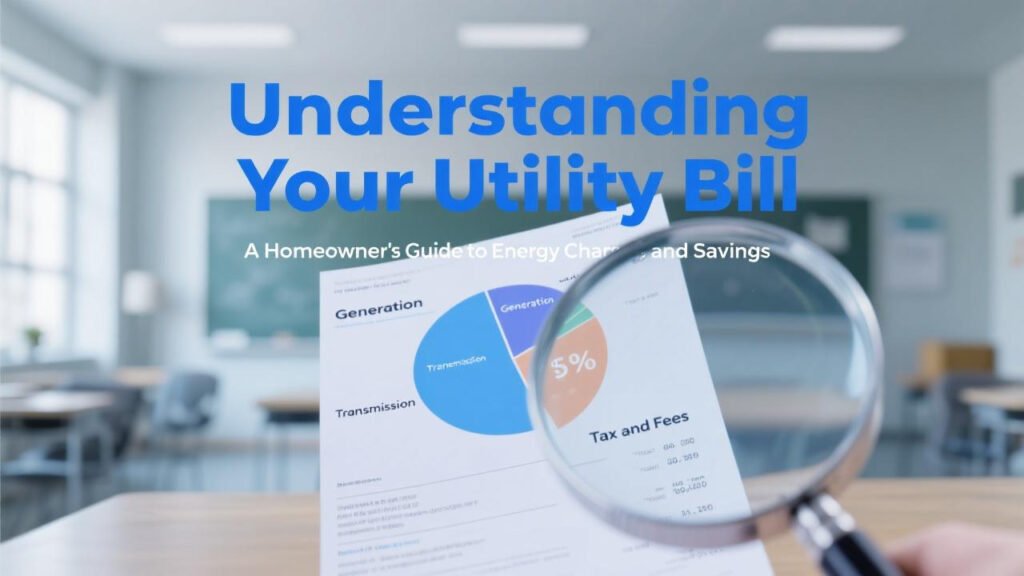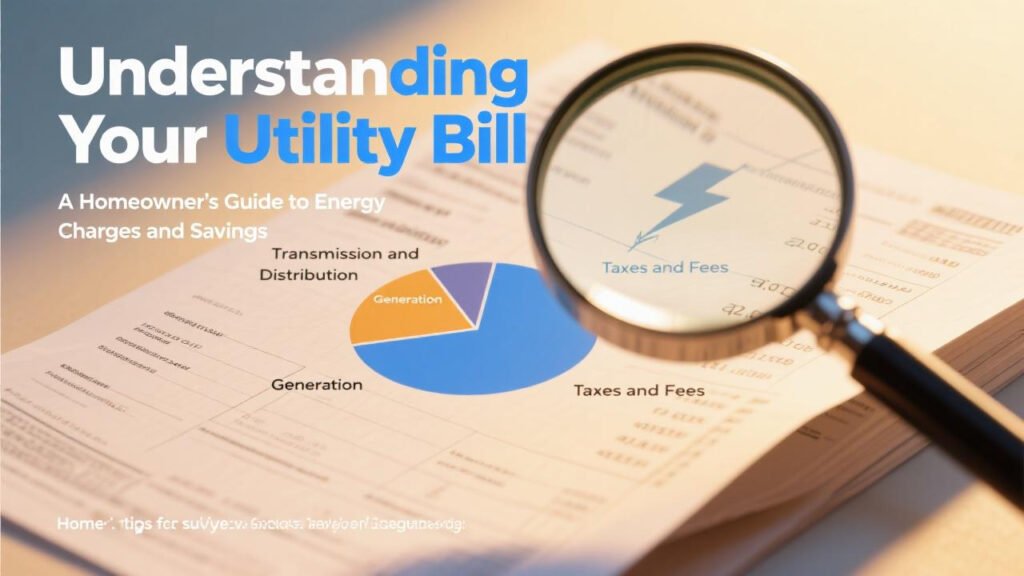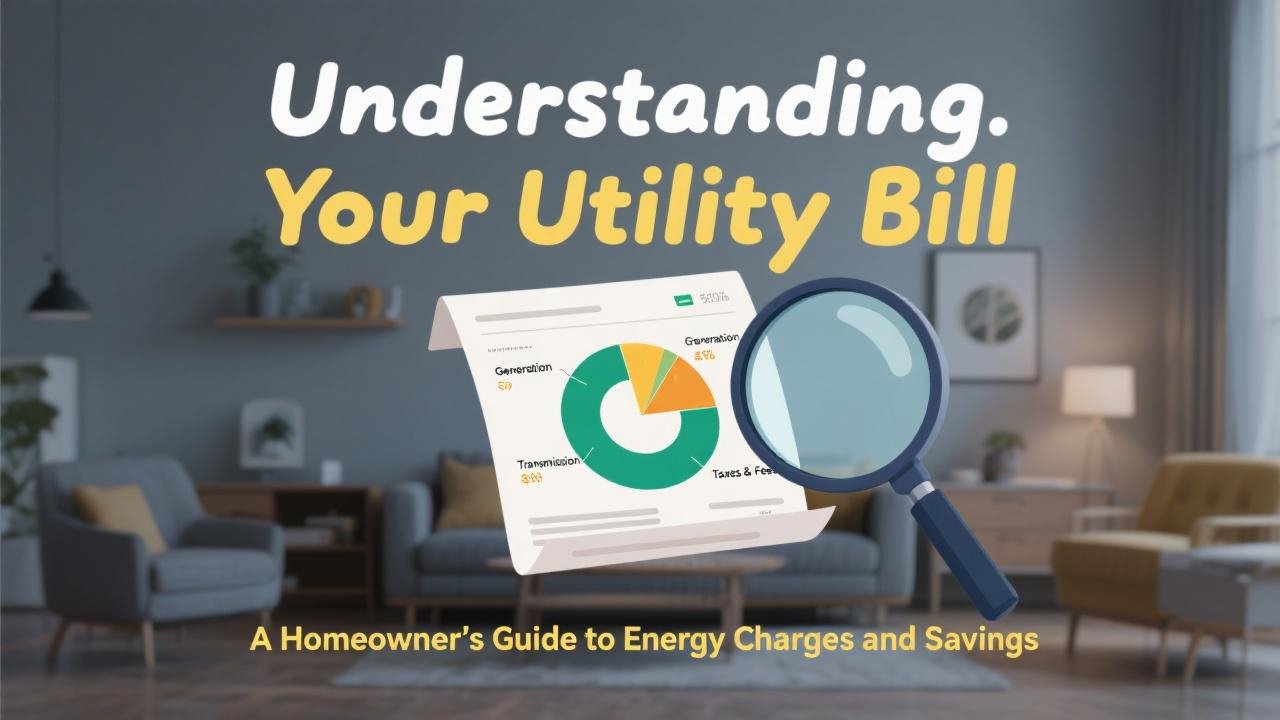Decoding the Dollars and Cents of Your Home Energy Use
Your monthly utility bill arrives like clockwork, but do you truly understand what all those charges, rates, and terms mean? For many homeowners in 2025, the electricity and natural gas bills can seem like a complex puzzle. However, taking the time to understand your utility bill is a crucial first step towards managing your energy consumption, identifying potential savings, and making informed decisions about energy efficiency upgrades or adopting renewable energy solutions like solar panels. This guide will help you decipher the common components of your residential utility bills.
Key Components of Your Electricity Bill:
While the format varies by utility provider, most electricity bills will include the following information :
- Account Information:
- Your name, service address, account number, billing period, and payment due date.
- Meter Reading Details:
- Meter Number: Identifies your specific electric meter.
- Previous and Current Readings: Shows the meter reading at the beginning and end of the billing cycle.
- Total Consumption (kWh): The difference between the current and previous readings, representing the total kilowatt-hours (kWh) of electricity your household consumed during the billing period. One kWh is the amount of energy used by a 1,000-watt appliance running for one hour.
- Breakdown of Charges: This is often the most complex section.
- Energy Charge (or Generation Charge): This is the cost of the actual electricity you consumed, usually priced per kWh. This rate can vary significantly based on your rate plan.
- Delivery Charge (or Transmission & Distribution Charge): This covers the cost of transporting electricity from power plants through the transmission and distribution lines to your home. This may also be a per-kWh charge or include fixed components.
- Fixed Charges (or Basic Service Charge, Customer Charge): A flat monthly fee that covers the utility’s fixed costs of providing service, such as meter reading, billing, and maintaining infrastructure, regardless of how much electricity you use.
- Taxes and Surcharges: Various local, state, and federal taxes, as well as surcharges for specific programs (e.g., energy efficiency programs, low-income assistance, renewable energy initiatives). Examples include Systems Benefits Charge or Environmental Benefits Surcharge.
- Fuel Adjustment Clause (or Power Supply Adjustment): Allows the utility to adjust charges based on fluctuations in the cost of fuels (like natural gas or coal) used to generate electricity.
- Rate Plan Information:
- Your bill should indicate the type of electricity rate plan you are on. Common types in 2025 include :
- Fixed-Rate Plan: You pay the same rate per kWh regardless of when you use electricity or how much you use (up to certain thresholds in some cases).
- Tiered-Rate Plan: The per-kWh rate increases as your consumption crosses certain usage tiers. For example, the first 500 kWh might be at one rate, the next 500 kWh at a higher rate, and so on.
- Time-of-Use (TOU) Plan: The per-kWh rate varies based on the time of day, day of the week, and sometimes the season. Electricity is typically more expensive during “on-peak” hours (high demand) and cheaper during “off-peak” hours (low demand).
- Electric Vehicle (EV) Rate Plans: Some utilities offer special TOU rates designed for EV owners, often with very low overnight off-peak rates for charging.
- Your bill should indicate the type of electricity rate plan you are on. Common types in 2025 include :
- Usage History:
- Many bills include a graph or table showing your electricity consumption over the past 12 months, allowing you to compare your current usage to previous periods and identify trends.
- Net Metering Details (If You Have Solar Panels):
- If you have a grid-tied solar panel system, your bill will look different and include :
- Energy Produced (by solar): Some bills might show this, or you’ll track it via your solar monitoring system.
- Energy Consumed (from grid): The amount of electricity you drew from the utility.
- Energy Exported (to grid): The amount of excess solar energy your system sent back to the utility.
- Net Energy Usage: The difference between energy consumed from the grid and energy exported to the grid. You are billed for this net amount.
- Solar Credits: Credits applied to your bill for the excess energy you exported. The value of these credits depends on your utility’s net metering or net billing policy (e.g., retail rate credit vs. avoided cost rate).
- Some utilities offer an Annual Billing Option (ABO) where you pay set fees monthly but settle net energy charges once a year, or a Monthly Billing Option (MBO) for full monthly settlement.
- If you have a grid-tied solar panel system, your bill will look different and include :

Key Components of Your Natural Gas Bill:
If you use natural gas for heating, cooking, or water heating, your gas bill will have similar components, but with different units of measurement:
- Account Information: Similar to your electricity bill.
- Meter Reading Details:
- Consumption: Measured in therms or CCF (hundred cubic feet). One therm is equivalent to 100,000 BTUs (British Thermal Units) of heat content.
- Breakdown of Charges:
- Gas Supply Charge (or Commodity Charge): The cost of the natural gas itself, priced per therm or CCF. This can fluctuate based on market prices.
- Delivery Charge: The cost of transporting the gas through pipelines to your home.
- Fixed Charges: Similar to electricity bills.
- Taxes and Surcharges.
- Usage History.
How Understanding Your Bill Helps You Save:
- Identify High Usage Periods: By looking at your historical usage and TOU data (if applicable), you can see when you use the most energy and identify opportunities to shift consumption to cheaper times.
- Spot Inefficiencies: A sudden spike in your bill without a corresponding change in weather or habits could indicate an appliance malfunction or energy leak in your home.
- Evaluate Rate Plans: Understanding your usage patterns can help you determine if you’re on the most cost-effective rate plan offered by your utility. For example, if you can shift significant usage to off-peak hours, a TOU plan might save you money.
- Measure Impact of Efficiency Upgrades: After making energy efficiency improvements (like adding insulation or installing a heat pump) or installing solar panels, your utility bill is the ultimate scorecard for measuring your savings.
- Inform Solar and Storage Decisions: Knowing your detailed energy consumption, especially hourly data if available from your utility through “Green Button Data” or similar initiatives, is crucial for accurately sizing a solar panel system and determining the potential benefits of a home battery.
Tips for Reducing Your Utility Bills in 2025:
Once you understand your bill, you can take targeted action:
* Conduct a Home Energy Audit: Identify where your home is losing energy and prioritize efficiency upgrades.
* Optimize for TOU Rates: If on a TOU plan, shift energy-intensive tasks (laundry, dishwasher, EV charging) to off-peak hours.
* Invest in ENERGY STAR Appliances: Replace old, inefficient appliances with ENERGY STAR certified models.
* Upgrade Lighting: Switch to LED bulbs.
* Improve Insulation and Air Sealing: This can significantly reduce heating and cooling costs.
* Install a Smart Thermostat: Program it to reduce heating/cooling when you’re away or asleep.
* Consider High-Efficiency HVAC: If your heating or cooling system is old, upgrading to a high-efficiency heat pump can drastically cut energy use.
* Explore Solar Panels: Generating your own electricity can dramatically reduce or eliminate your electricity bill.

Empowering Yourself Through Understanding
Your utility bill is more than just a request for payment; it’s a detailed report on your household’s energy habits. By taking the time to understand its components in 2025, you can gain valuable insights into where your energy dollars are going and identify numerous opportunities to save money, improve comfort, and reduce your environmental impact. This understanding forms the foundation for making smart decisions about energy efficiency upgrades and potentially transitioning to cleaner energy sources like solar, perhaps with the guidance of resources like EnergySage.



